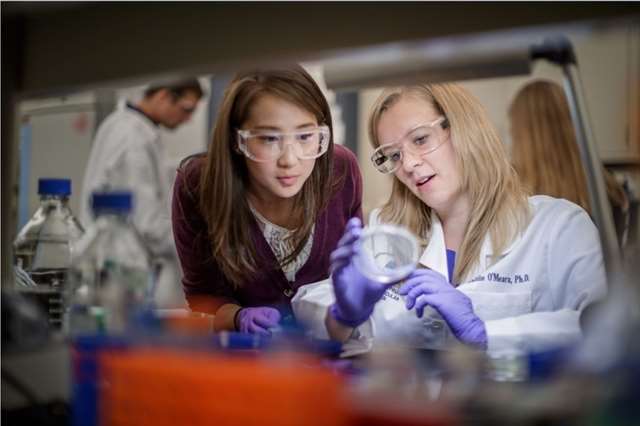Cracking the Code of a Shapeshifting Protein
Molecular switches can be used to detect cancer, construct nanoscale machines, and even build cellular computers. Many currently available molecular switches, however, rely on transcription and translation to switch “on,” and cellular degradation to turn “off,” meaning that they work slowly and sometimes irreversibly. Turning them on is like driving to the store, buying a lightbulb, going back home and screwing it in; and turning them off is like waiting for the bulb to burn out. Research efforts in the field have thus been devoted to developing molecular switches that work more like flicking a light switch on, and off, and on again. One way to build such switches would be to use metamorphic proteins: proteins that can adopt more than one distinct 3D shape, even under identical physiological conditions. But until now it has been difficult to define a workflow for intentional design of metamorphic proteins that could serve as nanoscale transformers optimized to perform specific biomedical functions.
Dishman and colleagues sought inspiration from nature to understand the molecular principles needed to create proteins that can assume either of two stable shapes in equilibrium. They studied the evolution of a naturally occurring metamorphic protein called XCL1, which performs two important and distinct functions in the human immune system. One conformation plays a role in directly killing invaders like viruses and bacteria, while a second attracts dendritic cells to recognize foreign antigens and kill the cells, like cancer cells, presenting them. Looking back in evolutionary time, the MCW team found that XCL1 evolved from an ancient, single-structure protein. Then about 200 million years ago XCL1 gained the power to shape-shift. By zeroing in on the precise historical timepoint when the protein started shifting between two shapes, the researchers were able to decipher the molecular code that allowed the molecular ancestors of the human XCL1 protein to become a transformer. In cracking this code, Dishman, et al. have outlined an “instruction manual” for engineering metamorphic proteins. These principles should be useful in a variety of applications, from developing biosensors to building nanoscale machines. It may now be possible, for example, to design a microscopic biobot incorporating a transformer protein acting as a drug delivery vehicle: In one conformation present in the circulation, the payload of cancer-killing drugs would remain isolated in the cargo bed. Upon approaching a tumor, signals from the cancer cells would switch the metamorphic protein into its other conformation, releasing the drug precisely at the tumor site and avoiding the damage to normal tissues that can make cancer patients sick.
“It has been an honor to work on this project,” says Dishman, a fourth-year graduate student in MCW’s physician scientist training program. “Our discoveries dispel some long-held misconceptions about fold switching proteins and their role in evolutionary biology. These results suggest that there may be far more shapeshifting proteins out there in the world than we ever expected. This project has been in the lab for almost a decade and it’s been rewarding to solve some of the difficult questions about the evolution of XCL1. Brian gave me freedom to pursue ideas I thought were interesting and to tell the story in ways that challenge the norms in our field, and for that I am grateful. I’m thrilled to get these findings published to the broader scientific community and hope that we can go on to devise technologies that directly apply these concepts for the benefit of patients.”
Adds Volkman, senior author and director of the MCW program in Chemical Biology, “Acacia’s Science paper is the culmination of work that spanned many years. It does not diminish her major achievement to point out that other talented people laid the foundation, and I am grateful to all of them, especially Rob Tyler, who launched the study of XCL1 ancestor proteins. I agree with Acacia that her paper is likely to become an important landmark for the study of metamorphic proteins. Her work demonstrates that fold switching is not a biological accident but a feature that can be preserved and optimized over evolutionary time scales. I expect her paper will put to rest an alternative view that metamorphic proteins arise only as temporary, intermediate steps in the emergence of new protein structures.”
This work was funded in part by NIH grants R37 AI058072, R56 AI103325, F30 CA236182, and F30 CA196040. Additional authors on the paper are Robert Tyler, PhD, former MCW post doc and current scientist at Thermo Fischer; Jamie Fox, PhD, MCW alumna and current scientist at Marshfield Clinic; Andrew Kleist, MD-PhD student at MCW; M. Madan Babu, PhD, Faculty and Center Director in the Departments of Structural Biology and Center for Data Driven Discovery at St. Jude Children’s Research Hospital; Kenneth Prehoda, PhD, professor at the Institute of Molecular Biology and Department of Chemistry and Biochemistry at the University of Oregon; and Francis Peterson, PhD, professor of biochemistry at MCW.
Keep up with the latest news. Sign up for Newsroom Alerts.
Latest press releases, stories and resources.
MCW Media Contacts
The media relations team at MCW is happy to assist in coordinating experts for interviews. Please reach out to us at:
media@mcw.edu
(414) 955-8764
Contact us


